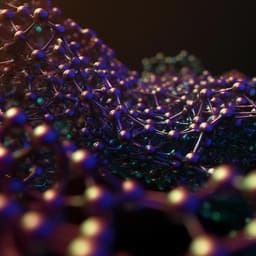
Physics
Machine learning using structural representations for discovery of high temperature superconductors
L. Novakovic, A. Salamat, et al.
This research conducted by Lazar Novakovic, Ashkan Salamat, and Keith V Lawler delves into the innovative application of machine learning to uncover high-temperature superconductors. Utilizing advanced structural representations to navigate the vast compositional phase space, the study highlights how pressure influences polymorphisms critical to superconductivity, achieving impressive accuracy in predicting transition temperatures.
~3 min • Beginner • English
Introduction
The study addresses the challenge of rapidly and accurately predicting superconducting transition temperatures (Tc) in materials, particularly hydrogen-rich compounds under high pressure where Tc can approach room temperature. Traditional ab initio calculations (e.g., Eliashberg theory and electron-phonon DFT) are accurate but computationally expensive, sensitive to methodological choices, and difficult to scale across complex, multi-component systems and structural polymorphs that vary with pressure. Existing machine learning models based on stoichiometry alone ignore 3D structural information and cannot capture pressure-induced changes in Tc or distinguish polymorphs, leading to difficulties with high-variance Tc measurements across pressures. The purpose of the study is to develop a structural representation and machine learning framework that incorporates periodic structural information to accurately and efficiently predict Tc across phases, pressures, and compositions, thereby accelerating discovery of high-Tc superconductors.
Literature Review
Prior work includes decades of experimental Tc data aggregated in the Supercon database (~30,000 entries). Stoichiometry-based ML models augmented with elemental properties (e.g., atomic mass, charge, valence) have shown good regression performance but lack structural sensitivity and cannot capture pressure or polymorphism effects. SOAP-based structural descriptors improved Tc prediction by encoding local atomic environments, yet remain limited by locality (cutoff radii) and may miss similarities between polymorphs or properties arising from full periodic structures (e.g., phonon dispersion). High-pressure hydride superconductors (e.g., H3S, LaH10, YH9, CaH6) have been successfully predicted by CSP and ab initio methods but at high computational cost, highlighting the need for ML models with structural descriptors that are periodic, normalized, and invariant to physically irrelevant transformations.
Methodology
Data: (1) Supercon data were cleaned and reformatted, grouping Tc measurements by composition and computing means/variances. A variance cutoff σ^2_T,cut = 2 was used to delineate low-variance entries (averaged Tc assigned) from high-variance entries; for baseline analysis, even high-variance compositions were averaged. (2) Structures corresponding to Supercon compositions were retrieved from Materials Project using pymatgen, yielding 2454 matched structures. (3) An additional set of 46 theoretical high-Tc hydride structures (various phases and pressures) was included; their Tc labels were taken as the average over reported μ* bounds from Eliashberg calculations.
Representation: Each crystal structure is mapped to periodic fields representing atomic charge and mass densities by placing Gaussian (or optionally von Mises) densities at atomic positions and summing over lattice periodic images. Gaussian widths scale with atomic number and outer atomic radius, and densities are normalized by atomic charge and mass. The periodic fields are represented via their complex Fourier coefficients F_Z,Γ(h;R0) over reciprocal lattice vectors, enabling a compact, periodic, and differentiable structural encoding that is invariant to cell choice and smoothly responsive to perturbations. For each structure, coefficients are truncated to a finite cube of reciprocal indices 0 ≤ h,k,l < δ, producing a 3D complex grid with 2 channels (mass and charge). The study used δ=13 and scaling γ_e=0.0025, γ_m=0.25, resulting in 13×13×13×2 complex inputs. Additional numerical descriptors (175 total) include: counts of each species (Z=1–86), 81 prior chemical descriptors, lattice parameters and angles, space group number, and volume.
Model: A two-branch neural network combines (i) a complex-valued 3D CNN branch for the structural density grids and (ii) a fully connected MLP for numerical descriptors. The CNN uses cvnn complex convolutions: two 3D conv layers (32 filters, 3×3×3 kernels), 2×2×2 average pooling, 50% dropout; first activation is cartesian ReLU, second uses absolute value to convert to real output which is then flattened. The numerical branch has four fully connected layers of 256 units each. The branches are concatenated and followed by four ReLU dense layers of 512 units with 50% dropout, and a single scalar Tc output. Training employed an 80/20 train-test split, Keras Huber loss (delta=7) to balance low and high Tc errors, up to 300 epochs with best validation model selection. Various processing choices were explored (including CVCNN vs real-valued encodings); the CVCNN provided the best general performance.
Evaluation and exploration: Model validation and case studies included known and theoretical hydrides, comparisons against composition-only models, and structure morphism studies by swapping species and uniformly scaling lattices to probe Tc domes and polymorph sensitivity.
Key Findings
- Predictive performance: Achieved r^2 = 0.9429 on the validation/test set without excluding high-variance compositions, indicating strong accuracy across a wide Tc range.
- Structural sensitivity: The model distinguishes polymorphs and captures pressure-like effects via uniform lattice scaling, reproducing superconducting dome behavior and revealing distinct lattice-response profiles for different phases (e.g., Fd3m vs P3m1 in Li2MgH16).
- Agreement with experiments and calculations: Predicted Tc ≈ 237 K for P63/mmc YH9 at 255 GPa (matches measured 237 K); predicted Tc for LaH10 (Fm3m, 150 GPa) close to measured 249 K; predicted Tc ≈ 177 K for a CSH7 polymorph aligns with vdW-corrected DFT estimate ≈174 K; Im3m SeH3 at 200 GPa predicted 113 K (DFT optimization gave 111 K). In contrast, composition-only models could not resolve phase/pressure dependencies and underpredicted cases like CSH7 (<37 K).
- Materials discovery via morphisms: Screening morphisms of Fm3m MgH13 suggested high-Tc candidates including LiMgH12 (max predicted Tc ≈ 356 K) and AlH13 (≈ 353 K). Sulfur-exchange variants of H3S (Im3m) yielded PH3 (≈ 191 K), BH3 (≈ 140 K), and SeH3 (≈ 113 K). For Li2MgH16-derived systems, random morphisms indicated candidates such as BaH32N5 and LaH32N5, and BaH32N4O and LaH32N4O with Tc > 350 K; systematic XYH36 morphisms (Li replaced by H) revealed multiple candidates with Tc > 400 K (e.g., LiLaH36, ZrH36Cl, TeH36N).
- Computational efficiency: Compared to weeks-long electron-phonon calculations for large cells, the model provides rapid Tc estimates enabling broad exploration of composition and structure spaces.
Discussion
By embedding periodic structural information as smooth mass and charge density fields and learning with a complex-valued 3D CNN, the model directly addresses the limitations of stoichiometry-only approaches and local-environment descriptors. It captures how Tc varies with structure and pressure, differentiates polymorphs, and generalizes across a wide range of superconductors, particularly high-pressure hydrides where structure and pressure are decisive. The strong agreement with measured and DFT-computed Tc values in benchmark hydrides validates the approach. The capacity to map Tc vs lattice scaling and to screen structural morphisms provides actionable guidance for experiment and theory, prioritizing candidates for detailed ab initio study and high-pressure synthesis. Overall, the findings demonstrate that structural representations with periodicity and physical interpretability are crucial for accurate, scalable Tc prediction and accelerate the discovery pipeline.
Conclusion
The work introduces a structural representation—periodic mass and charge density fields in Fourier space—combined with numerical descriptors and a complex-valued CNN to predict superconducting Tc with high accuracy (r^2 ≈ 0.94). The model captures polymorphism and pressure effects, reproduces superconducting domes, and outperforms composition-only baselines. It predicts Tc values consistent with experiments and DFT for several hydrides and identifies new high-Tc candidates through systematic morphisms (e.g., LiMgH12, AlH13, PH3, BH3, SeH3, and multiple XYH36 compositions). The approach enables rapid screening at scale and, when integrated with crystal structure prediction, can form an efficient discovery workflow. Future work should incorporate larger and more diverse structure-resolved Tc datasets, refine density representations with CSP-informed electron/mass distributions, and pursue experimental and theoretical validation of top candidates, including optimization toward lower-pressure stability.
Limitations
- Label uncertainty: Many Supercon entries have pressure-dependent Tc and structural polymorphism; the study used averaged Tc labels even for high-variance compositions (σ^2_T ≥ 2), which may blur structure-Tc relationships. More precise matching of structure, pressure, and Tc would improve fidelity.
- Domain coverage: Training data may underrepresent complex multi-component hydrides and exotic phases; generalization to extreme regimes (very strong electron-phonon coupling, ultra-high Tc) can be less reliable, as suggested by discrepancies for some Li–Mg–H systems.
- Representation approximations: Gaussian/von Mises density parameters (γe, γm, widths) are heuristic; using more accurate CSP-derived electron/mass densities could further enhance performance. Truncation of Fourier coefficients (δ=13) trades detail for efficiency.
- Computational search space: Even with fast inference, morphism spaces are astronomically large; practical exploration still requires constraints, heuristics, and subsequent ab initio validation.
- External factors: Sensitivity of ab initio reference Tc to density functionals and μ* choices complicates benchmarking; experimental uncertainties (e.g., phase identification under pressure) also affect labels.
Related Publications
Explore these studies to deepen your understanding of the subject.







